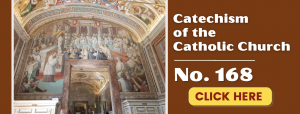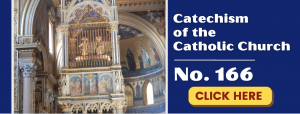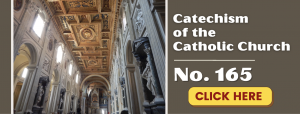Wednesday of the Thirty-third Week in Ordinary Time

WEDNESDAY, NOVEMBER 18TH Lk. 19: 11-28 “I tell you, to everyone who has, more will be given, but from the one who has not, even what he has will be taken away.”
Part 1: Introductory Commentary
Part 2: IMITATE THE VIRTUES OF MARY – THE BIG TEN by Fr. Ed Broom, OMV
- Jesus says, “No one can serve two masters.” (Mt. 6:24) This is the Two Standards of Saint Ignatius of Loyola. We either serve Satan, the prince of this world, or we serve Christ the King. How are we to serve Christ?
- Jesus says, “Amen, I say to you, unless you are converted, and become as little children, you shall not enter the kingdom of heaven.” (Mt. 18:3)
- Saint Paul says, “When I was a child, I spoke like a child, I thought like a child, I reasoned like a child. When I became a man, I gave up childish ways.” (1 Cor 13:11)
- Is Paul contradicting Christ? As adults, we have responsibilities that children do not have. We are to provide for our children and protect our children from the modern wolves that seek to devour them – such as pornography and the LGBT agenda.
- How do we reconcile this? The answer lies in who God is and who we are. God is the Eternal Being who always was and always will be; He is without beginning or end. He is all-knowing and all-powerful. He is the Creator and we are His creatures.
- By the merits of Christ’s crucifixion and death on the cross, we become children of God through Baptism, sharing in His Divine life through sanctifying grace. Sharing in His Divine life also means sharing in His Divine work – the salvation of souls.
- This explains Christ’s command to become as little children and Paul’s assertion that we must give up childish things. We are to do a “man’s” work with the obedience of a little child – a child of God! Saint Teresa of Avila told her nuns to pray con pantalones (with pants) – like a man! I can imagine she also told them to work con pantalones!
- This is a list of Paul’s trials and sufferings, penned by his own hand, that he willingly endured under obedience to the Will of God! “I have worked much harder, been in prison more frequently, been flogged more severely, and been exposed to death again and again. Five times I received from the Jews the forty lashes minus one. Three times I was beaten with rods, once I was pelted with stones, three times I was shipwrecked, I spent a night and a day in the open sea, I have been constantly on the move. I have labored and toiled and have often gone without sleep; I have known hunger and thirst and have often gone without food; I have been cold and naked. Besides everything else, I face daily the pressure of my concern for all the churches.” (2 Cor 1: 23-28)
- For Saint Ignatius, obedience was the sine qua non – without which nothing, or the essential virtue. He says, “Obedience is the source and protection of all other virtues.”… “Obedience is nothing less than a holocaust. It is there that we offer ourselves completely, without excluding any part of ourselves, in the fire of our love to our Creator and Lord at the hands of his ministers. By obedience one puts aside all that one is, one dispossesses oneself of all that one has, in order to be possessed and governed by Divine Providence.” He expressed this in the following prayer:
Take, Lord, and receive all my liberty, my memory, my understanding, and my entire will, all that I have and possess. You have given all to me. I surrender it all to you. Dispose of it according to your will. Give me your love and your grace that is enough for me.
- One person in all history was perfectly obedient to the Will of God – the Blessed Virgin Mary, known as the Immaculate One! We have prayed with this article before. Let us ask ourselves today if we have grown in these virtues of Mary, particularly the quintessential virtue of Blind Obedience!
PART 2: IMITATE THE VIRTUES OF MARY – THE BIG TEN by Fr. Ed Broom, OMV
From the cross, Jesus gave the person He loved most on earth, His Blessed Mother Mary, to Saint John and to us as our Mother most holy! May we strive to know Mary, to love Mary, and to imitate Mary a little more every day. In his Marian Spiritual Masterpiece, True Devotion to Mary, Saint Louis de Montfort highlights ten of the most important virtues of the Blessed Virgin Mary. Let us put forth this list of Mary’s principal virtues.
We read in the text of True Devotion to Mary by Saint Louis de Montfort (# 108): Third, true devotion to our Lady is holy, that is, it leads us to avoid sin and to imitate the virtues of Mary. Her ten principal virtues are: deep humility, lively faith, blind obedience, unceasing prayer, constant self-denial, surpassing purity, ardent love, heroic patience, angelic kindness, and heavenly wisdom.
Let us humbly beg our Blessed Mother Mary for the grace to understand these ten virtues that she practiced always to a heroic degree of perfection, but also let us beg for the grace to be able to put these virtues into practice in our daily walk of life!
1. DEEP HUMILITY. A humble person recognizes that all the good they have done, and can do, is a result of the Presence of God in their life. Mary was most humble, calling herself the servant or the handmaid of the Lord. Also, in her magnificent canticle of praise that we call The Magnificat (Lk. 1:46-55), Mary states that God has looked with favor upon the humility of His handmaid. Let us beg Mary for a meek and humble heart so that like her, we will attribute our successes to God and our failures to ourselves.
2. LIVELY FAITH. Faith is one of the three theological virtues—faith, hope, and charity. Faith is believing in God and His Word without seeing with our eyes. Jesus gently reproved the doubting Thomas with these words: “Blessed are those who believe without seeing.” (Jn. 20:29) Mary is the woman of faith par excellence. Even though Mary witnessed the Passion, suffering, and death of Jesus, she believed that He would conquer death. Therefore, when we are tempted to doubt, let us turn to Mary, the woman of faith, and beg for her most powerful intercession.
3. BLIND OBEDIENCE. By giving her consent in the Annunciation—“Behold, I am the handmaid of the Lord; be it done to me according to your word.” (Lk. 1:38)—Mary displayed an admirable attitude of obedience to the Word of God and trust in His holy will. When we are tempted to rebel and turn against God, let us, through Mary’s prayers and example, obey God like Mary, and like Jesus who “was obedient to death, even death on the cross.” (Phil. 2:8)
4. UNCEASING PRAYER. Prayer can be defined as communication with God. There is no better example in the world, aside from Jesus, with respect to a life of constant prayer then that of the Blessed Virgin Mary. Scripture tells us, “Mary pondered these things in her heart.” (Lk. 2:19) Continually she thought of God in her mind and loved God with all of her heart; she maintained constant communication with the Blessed Trinity: the Father, the Son, and the Holy Spirit. The devil of laziness can attack all of us. May Our Lady inspire us to be constant, fervent, and faithful in prayer! Indeed, prayer is the key to our salvation. What air is to the lungs, prayer is to the soul!
5. CONSTANT SELF-DENIAL. Another way of wording this is mortification—the ascetical life which leads to the mystical life of union with God. Mary denied and sacrificed herself in all times and places. By doing so, she gave full reign for God to work in the entirety of her life. In Mary’s approved Apparitions, both in Lourdes and Fatima, she strongly encouraged the practice of prayer, but also that of sacrifice. By making sacrifices we are imitating Mary in the art of self-denial. Self-denial turns us towards God and away from self. Mary was always God-centered and never self-centered. May this be our style of life!
6. SURPASSING PURITY. One of the most sublime virtues that characterizes the most Blessed Virgin Mary is that of her spotless purity; Mary is known as the Immaculate One. In Fatima, Our Lady sadly expressed that most souls are lost to the eternal fires of hell due to sins against the virtue of holy purity. Mary is the Perpetual Virgin. She was virgin before the birth of Jesus, during the birth of Jesus, and after the birth of Jesus. True devotion to Mary can help us maintain our purity, and if we have lost it, to seek restoration through Sacramental Confession. Contemplating a beautiful picture, painting, or statue of Our Lady can instill in us noble aspirations for purity.
7. ARDENT LOVE. Of all the virtues that we are called to practice, that of ardent love, sometimes called charity, is the greatest. Read the beautiful hymn of love of Saint Paul: I Corinthians 13. Our Lady practiced love to a sublime degree and in two ways, for love or charity has two dimensions. Mary at all times and in all places loved God first and foremost. However, Mary expressed concretely her love for God by ardent love for her neighbor. Examples of this. In the Annunciation, through her unconditional Yes Mary showed her total and unreserved love for God. However, moving in haste to visit her cousin Elizabeth, Mary manifested great love for her neighbor. In imitation of Mary, may we say in the words of Saint Paul, “The love of God compels me.” (2 Cor 5:14) May we learn this double commandment—love of God and love of neighbor—and strive to live it out on a daily basis. Saint John of the Cross states: “In the twilight of our existence, we will be judged on love.”
8. HEROIC PATIENCE. Not one of us can say that we are patient at all times, in all places, and in all circumstances. Unlike Mary, who manifested remarkable patience! Consider Mary in her pregnancy traveling the long trek to Bethlehem and then being rejected—what great patience! Losing the Child Jesus when He was twelve years of age for three long days before finding Him in the Temple—another manifestation of heroic patience! Most especially, in accompanying Jesus in His Passion leading up to His brutal Crucifixion and death, Mary manifested an unequaled patience! When our patience is put to the test, let us call out to Mary for her assistance. She will never fail us!
9. ANGELIC KINDNESS. The opposite of kindness is rudeness. Just try to imagine the way and manner in which Mary must have treated her neighbor! A warm welcome, a kind and winning smile, courtesy to the maximum, an attentive ear to listen—all of these are clear manifestations of kindness, angelic kindness. Mary did all this to the highest degree! Saint Frances de Sales on this virtue commented: One can attract more flies with a spoonful of honey then with a barrel full of vinegar. In other words, kindness attracts others to Christ while rude and drastic measures repel them. May Our Lady teach us what it means to be kind and may we put it into practice!!!
10. HEAVENLY WISDOM. One of the sublime titles given to Mary in her glorious Litany is that of SEAT OF WISDOM. A wise person knows what is most important in life. Dynamic love for God and ardent desire for the salvation of immortal souls are hallmarks of true wisdom. Our Lady had a burning love for God and an ardent desire for the conversion of sinners and their eternal salvation. “The Blessed Virgin persevered in her union with her Son unto the cross… joining herself with his sacrifice in her mother’s heart.” (Vat II, Lumen Gentium) King Solomon was once wise, but he gave into his weakness—that of lustful desires—and ended his life a fool. We beg the intercession of Our Lady Seat of Wisdom to attain for us not only wisdom now, but perseverance in this sublime virtue until the very end!
In conclusion, may we ardently desire to know, love, and imitate our Blessed Mother Mary! May we be motivated with a firm decision to meditate frequently and fervently on the virtues of Mary most holy and then strive to live them out all the days of our life! Holy Mary, Mother of God, pray for us sinners, now and at the hour of our death. Amen.
Copyright 2020 Oblates of the Virgin Mary
St. Peter Chanel Church, Hawaiian Gardens, CA













